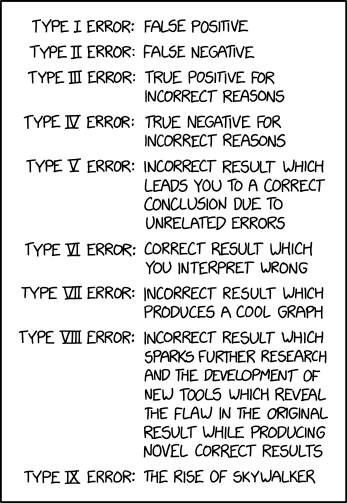Error types
« previous post | next post »
Today's xkcd:

Mouseover title: "Type IIII error: Mistaking tally marks for Roman neumerals" [sic]
I was going to ask for your favorite (quasi-)scientific error examples, but then I realized that this just an inventory of testing-result types, so that things like p-hacking, file-drawer phenomena, confirmation bias, etc., are in a different space.
mg said,
May 7, 2020 @ 5:27 pm
I love the Type IX error!
And as a statistician/medical researcher, I love seeing all the other errors, too.
D.O. said,
May 7, 2020 @ 6:43 pm
Despite discouraging last paragraph, I submit "Type 0 error: performing a test when one is either not necessary or inppropriate". This applies to both medical and statistical significance tests.
ardj said,
May 7, 2020 @ 6:51 pm
further to D.O.: and of course Types-I, &c of investigating the wrong things, doing it wrongly, &c, &c
Orbeiter said,
May 7, 2020 @ 7:11 pm
Is the mouseover text trying to be meta or has Randall made an error there?
According to memory, the Romans would on occasion write IIII to represent 4. Wikipedia appears to confirm that my memory was accurate.
https://en.wikipedia.org/wiki/Roman_numerals#Variant_forms
"On the numbered gates to the Colosseum, for instance, IIII is systematically used instead of IV, but subtractive notation is used for other digits; so that gate 44 is labelled XLIIII"
So IIII _could_ be Roman numerals.
Timothy Rowe said,
May 7, 2020 @ 7:17 pm
IIII could indeed be Roman numerals. Or they could be tally marks. But confusing tally marks for Roman numerals would be an error. Rather close to a Type III or Type IV error – getting a correct result for incorrect reasons.
cameron said,
May 7, 2020 @ 7:37 pm
The fact that IIII was in fact sometimes used as a Roman numeral just increases the likelihood of category IIII error occurrences.
Bob Ladd said,
May 8, 2020 @ 12:22 am
The John D.Rockefeller Jr. Library at Brown University was opened in 1964, or, as it says at the entrance, MDCCCCLXIIII. When it was opened, somebody is reported to have remarked "I thought Brown was an IV League university".
jaap said,
May 8, 2020 @ 6:21 am
On clockfaces it seems to be traditional to use IIII instead of IV.
I noticed that this makes every letter occur a multiple of four times, so if you produce four batches of "XVIIIII" you have exactly the required letters to cover the hours of the clock. I don't know if this curious fact has had any effect on the prevalence if this usage of IIII on clocks or otherwise.
Milt Boyd said,
May 8, 2020 @ 6:55 am
I've been told that IIII on a clock balances nicely with VIII on the other side of the dial, and the whole looks better with symmetry.
bks said,
May 8, 2020 @ 7:12 am
Type XIII error: Statements of probabilities are probably wrong.
unekdoud said,
May 8, 2020 @ 7:48 am
Type–Ⅰ Error: misnegation.
Philip Taylor said,
May 8, 2020 @ 8:40 am
Type-0 error : assuming that arrays, lists, etc., start at I.
Robert Coren said,
May 8, 2020 @ 9:25 am
I thought the IIII on clock faces was to avoid confusion between IV and VI, given that the numbers on a clock face are often not upright.
Chester Draws said,
May 8, 2020 @ 4:51 pm
I thought the IIII on clock faces was to avoid confusion between IV and VI, given that the numbers on a clock face are often not upright.
But they use both IX and XI, rather than VIIII and XI.
===Dan said,
May 8, 2020 @ 5:04 pm
"neumerals" has been corrected in the original.
David Marjanović said,
May 8, 2020 @ 7:02 pm
I'm going to use the terms "type-III error" and "type-IV error" for real. Such errors are really common, after all.
Robert Coren said,
May 9, 2020 @ 8:21 am
Chester Dawes: Good point. I was going to say I thought I'd seen VIIII, but on reflection I don't think I have.
Amanda Adams said,
May 9, 2020 @ 1:50 pm
Calligraphers, if they are taught at all, are (or were?) taught never to subtract. We are told subtraction (IX, IV) is an invention of Swiss clockmakers. That maths cannot be done with subtractive notation. We are also taught that we need not confine ourselves to majuscules. (Of course, later, we are taught to make intriguing dedications for buildings or weddings with hidden Roman numerical notation).
Are we accepting authorities too unquestioningly?
David Marjanović said,
May 17, 2020 @ 6:45 am
Nobody anywhere near Rome had mathematics in mind when the Roman numerals were invented.